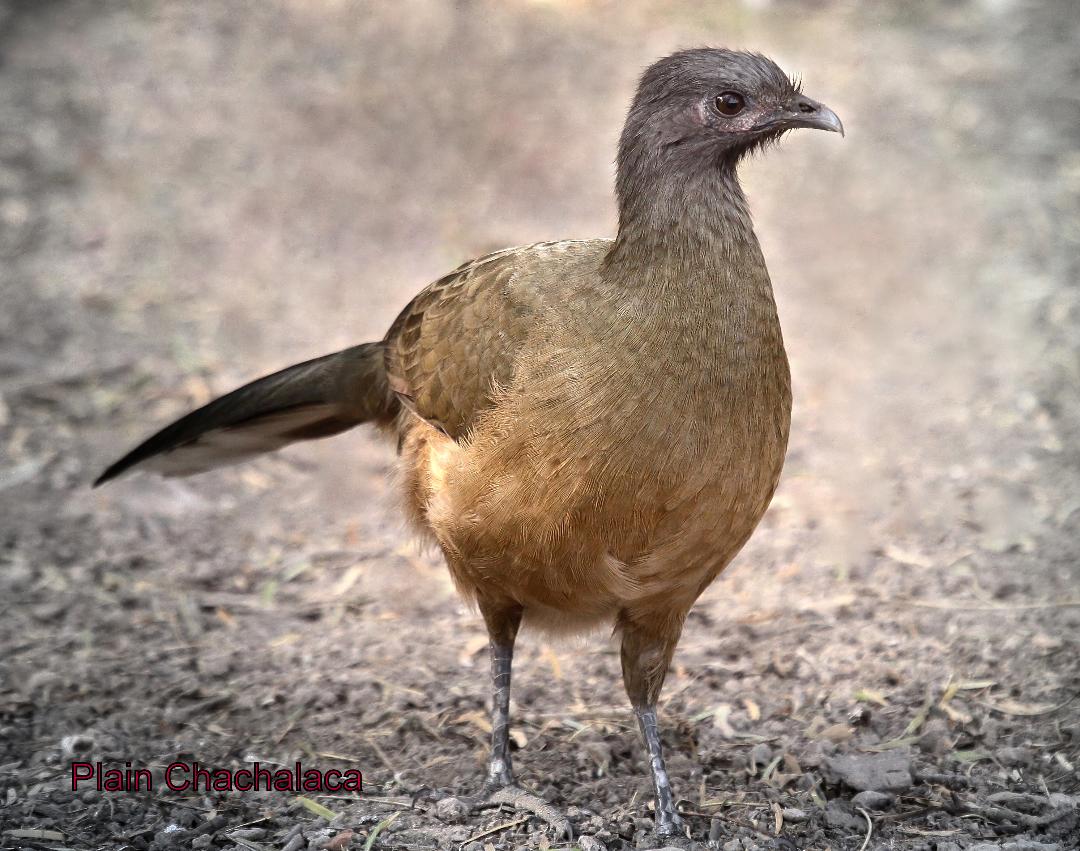photo by Charles Lorenz
Many a chatty person in the Rio Grande Valley answers to the pet name “Chachalaca”—and it’s really no wonder.
The birds’ cries of Cha-cha-lac, cha-cha-lac!— a rocking, overlapping call-and-response—resound from trees and shrubs, especially in spring and summertime mornings and evenings. Intermixed with the industrial whine of summer cicadas, nearby humans get quite an earful. Yet locals adore these raucous neighbors. Our local chapter of Texas Master Naturalists’ newsletter is The Chachalaca, and its insignia adorns many shirts and pins.
Oddly, while we can’t help but hear chachalacas hailing one another from tree-to-tree, we often don’t spot them. Though hunting chachalacas in Texas is permitted and regulated, few attempt it since the birds, preferring dense foliage, conceal themselves so well—a worthy talent for a plump bird which, along with its eggs and offspring, provides a succulent treat for such as coyotes and bobcats. Chachalacas readily emerge, though, to peck for proffered seeds at nearby feeders.
Our local resident, the plain chachalaca (Ortalis vetula) is one of sixteen species—all North American and the only one living in the United States. The chachalaca joins other heavy birds, including chickens, turkeys and quail in the order Galliformes. Its genus name, Ortalis, comes from a Greek word for domestic hen, while its species name, vetula, derives from a Latin word meaning “old woman” or “old wife”—an interesting moniker since it’s the male’s, not the female’s, deep cha-cha-lac that initiates the raucous calls. The bird’s onomatopoeic name arises from a Nahuatl verb meaning “to chatter”.
Readily identifiable, the nearly two-foot long chachalaca has a small head with a slight crest and a rounded, white-tipped dark green tail. From above, feathers appear gray or brownish olive. Skin on both the male’s and female’s throats turn pinkish red during breeding season. Plain chachalacas thrive in tall, dense brushlands from the Rio Grande Valley southwards through Central America.
Plain chachalacas—sometimes feeding in awkward positions, including hanging upside down on skinny branches— enjoy a variety of flowers, leaves and fruit from such native plants as honey mesquite, sugar hackberry and Mexican ash. Remaining alert, they enter open grounds, then flutter back into trees when discomfited. Chachalacas may also eat insects and, at a feeder, seeds like milo and cracked corn.
Chachalacas’ nesting season usually runs from May through July or later, but their calls increase as early as February. Chachalacas, which appear to be monogamous, work cooperatively to care for their offspring. Courting birds feed and also preen one another, focusing on the head, neck and base of the tail.
Chachalacas commonly nest upon branches or within tree crotches, often surrounded by Spanish moss or vines, for concealment. Sometimes, however, they lay eggs on broken branches or stumps, and they may reuse other birds’ nests. Both construct the nest, consisting of sticks, Spanish moss and other debris. The female incubates the eggs, while the male provides defense.
Shortly after birth, downy, precocial (born independent) chicks, following their mother, clamber along branches and down to the ground to feed. Chicks fly, in brief spurts, four to six days later. Parents tend to them, but usually chicks catch and eat insects for themselves. Chachalaca parents continue to groom one another and their chicks, who soon merge into familial groups till time for pair-bonds to form.
Chachalacas, most comfortable walking, fly in quick, quiet, but heavy bursts, dexterously gliding through tangled vines. Their calls include the loud, rhythmic, overlapping cha-cha-lac, initiated by a male, whose pitch—due to tracheal differences—is lower than the female’s. Other vocalizations include a churr, churr or purr-r-r, likely a contact note to maintain closeness and warn others of danger and a cak-kak-kak or gluck, gluck, an alarm or aggressive call, one also used to rein in chicks, who respond with a soft peep. Also, agitated birds may abruptly squawk or squeal, prompting their alarmed fellows to flutter into trees. Distressed by an intruder, a chachalaca may assume a threat posture—standing straight, with neck and head outstretched and crest erect— or, upon occasion, fight, grabbing, clawing with feet, pecking and jumping upwards or even jumping on top of a foe. Small flocks of chachalacas may harass and attack opossums and eastern screech owls.
Local chachalacas, many of their communities nestled into parks and refuges, appear to be thriving, but they require habitat protection. The birds are easily domesticated, sometimes by placing chachalaca eggs under a domestic hen. Farther south, some are taken by subsistence hunters. Some biologists consider the flocks we observe here to be semi-domesticated—since they come to feeders—and wonder if they are accurately observing chachalacas as a wild species.

